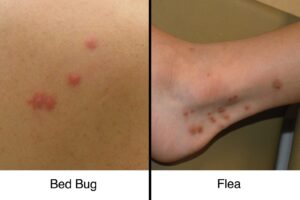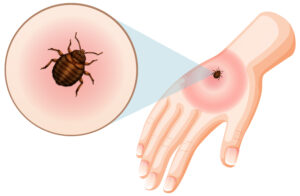Bed Bug Bites vs Flea Bites: Know the Difference Immediately!
The battle of Bed Bug Bites vs Flea Bites is a common yet unpleasant one. Each type of bite comes with its own set of problems, and identifying them correctly is the first step toward resolution. As an advisor in pest control, I’ve encountered numerous clients bewildered by the biting situation they are facing. The discomfort and the itchiness can be quite a nuisance, hence understanding the difference between these two types of bites is crucial. Through this article, I aim to provide a detailed insight that would help you distinguish between bed bug bites and flea bites, and tackle them effectively.
Identifying the Culprits
Characteristics of Bed Bugs
Bed bugs, scientifically known as Cimex lectularius, are small insects that measure about 5 to 7 mm in length. They possess a flat, oval-shaped body which is reddish-brown in color. This shape allows them to easily hide in crevices during the day and come out to feed during the night.
The life cycle of a bed bug includes various stages from egg to adult. They undergo a process known as incomplete metamorphosis, which includes the stages of egg, nymph, and adult. The nymph stage has five sub-stages, and
- 100% Kill Efficacy Bedbugs, Mites, Eggs
- Lasting Protection
- USDA BIO-certified
- Plant Extract Based & Non-Toxic
- Child & Pet Safe
Characteristics of Fleas
Fleas, on the other hand, are a different kind of nuisance. They are tiny insects, measuring about 3 mm in length, with a dark reddish-brown color. Unlike
Fleas are parasitic insects that feed on the blood of mammals and birds. While their preferred hosts are animals, they can and will bite humans in the absence of their preferred hosts. A distinguishing characteristic of fleas is their ability to reproduce rapidly. A single pair of fleas can produce thousands of offspring in a matter of weeks under favorable conditions. This reproductive capability makes flea infestations incredibly hard to control, especially in environments with a lot of host animals.
Comparing Bites
When it comes to distinguishing between Bed Bug Bites vs Flea Bites, understanding the nature of their bites is crucial. Both bites result in red, itchy bumps, but there are subtle differences. The reaction to these bites can range from mild to severe, depending on an individual’s sensitivity. It’s essential to know the difference to address the problem effectively and prevent future bites.
The location of the bites on the body can also provide a clue.
Appearance
The appearance of bites is one of the most telling signs when distinguishing between bed bug bites and flea bites. Bed bug bites usually appear as small, flat, or raised bumps on the skin. They are red and may be itchy. They often occur in a line or clustered together, which is a distinctive feature of bed bug bites.
On the other hand, flea bites are usually scattered and not grouped in threes or a linear pattern. They appear as small red bumps, often with a red halo around the bite center. The halo around a flea bite is a distinctive feature that differentiates it from a bed bug bite. The appearance of the bites can provide valuable clues as to which pest you’re dealing with.
- 100% Kill Efficacy Bedbugs, Mites, Eggs
- Lasting Protection
- USDA BIO-certified
- Plant Extract Based & Non-Toxic
- Child & Pet Safe
Symptoms
The symptoms of bed bug bites and flea bites can vary from person to person. Bed bug bites are usually painless at first, with symptoms developing later. These symptoms may include intense itching, redness, and swelling. In some cases, individuals may develop an allergic reaction leading to larger welts or hives.
Flea bites, in contrast, are usually immediately itchy. They can also be painful and can cause allergic reactions in some individuals. Fleas can also transmit diseases through their bites, which is a significant concern. The immediate and intense itching caused by flea bites can result in excessive scratching, which may lead to secondary skin infections.
Duration and Healing
The duration and healing of bed bug bites and flea bites can also help in identifying the culprit. Bed bug bites may take anywhere from a few days to two weeks to heal, depending on the individual’s reaction and if an infection occurs from scratching. It’s advisable to avoid scratching to prevent infection and speed up the healing process.
Flea bites, on the other hand, may heal within a week if they don’t become infected. However, if an individual scratches the bites and causes an infection, healing may take longer. It’s crucial to keep the affected area clean and avoid scratching to promote faster healing. Over-the-counter creams and ointments can provide relief from itching and help in the healing process.

Where They Live
The habitats of
Moreover, the living environments of
How Big Are
Bed Bug Habitats
Bed bugs are primarily indoor pests that have a penchant for human environments. They prefer living in places where they have easy access to their human hosts. Common habitats include mattresses, box springs, bed frames, headboards, and other furniture with crevices. They can also be found behind wallpapers, under carpets, and in the cracks of wooden floors. Essentially, any place close to where humans sleep or rest can be a potential bed bug habitat.
In more severe infestations,
Flea Habitats
Fleas, in contrast, are more common in environments with pets. They prefer living on the bodies of animals like dogs and cats, where they feed and reproduce. However, they can also thrive in various areas within a home. Common indoor habitats include carpets, rugs, upholstery, and pet bedding. They can also be found in the yard, especially in shaded, protected areas where pets or other animals might rest.
Fleas lay eggs on their host animals, but these eggs often fall off into the environment, leading to widespread infestations. Flea larvae develop in dark, protected places, often deep within carpets or in the soil. The capacity for fleas to lay hundreds of eggs at a time, coupled with their rapid lifecycle, can result in severe infestations in a short amount of time. Understanding flea habitats is crucial for effective flea control and for preventing re-infestation.
- Kills Bed Bugs & Their Eggs
- Surface spray to beds, mattresses and more
- Intended for indoor residential
- Helps to treat deep into cracks and crevices
Health Implications
The health implications of
Moreover, the psychological stress and anxiety associated with infestations should not be underestimated. The presence of biting insects in one’s home can cause significant emotional distress, affecting sleep quality and overall well-being. This section highlights the health implications of

Prevention and Control
Preventing and controlling infestations of
Moreover, controlling an existing infestation is a more daunting task. It requires a combination of chemical treatments, heat treatments, or even cold treatments alongside rigorous cleaning and monitoring. The success of control measures greatly depends on the accuracy of identification of the pest and the extent of the infestation. Both
Bed Bug Prevention
Preventing bed bug infestations primarily involves avoiding contact with these pests. When traveling, it’s advisable to inspect hotel rooms, especially beds and furniture, for signs of
Additionally, employing protective measures like using bed bug encasements on mattresses and box springs, reducing clutter, and sealing cracks and crevices can deter
Flea Prevention
Flea prevention is heavily centered around pet care. Regularly treating pets with veterinarian-approved flea treatments is essential. Keeping your home, especially areas where pets frequent, clean and vacuumed can help prevent flea infestations. Washing pet bedding and your bedding frequently in hot water can also deter flea populations from growing.
In addition, maintaining a tidy yard by mowing the lawn and clearing debris can discourage fleas from breeding in your outdoor space. Employing flea preventatives like sprays, powders, or flea collars can also be part of an integrated flea control program. Consulting with a vet for the best preventive measures for fleas is always a good practice to ensure the health and comfort of your pets and household.
- Bedbug Detection and Protection
- Effective, Heav Duty, Versatile Design
- Use under bed posts and furniture legs
- Bed bugs climb in but cannot climb out
Effective Treatment
Effective treatment for bed bug and flea infestations requires a multi-faceted approach. It may involve chemical treatments, biological control, or even mechanical methods like vacuuming and heat treatment. The right treatment plan will depend on the extent of the infestation, the species of pest, and the level of discomfort being experienced.
Moreover, professional pest control services are often the most effective way to handle severe infestations. They have the knowledge, experience, and tools necessary to eliminate these pests in a safe and efficient manner. Engaging professionals can also provide peace of mind and ensure that the treatment is thorough and long-lasting.
Treating Bed Bug Bites
The treatment for bed bug bites primarily focuses on relieving the symptoms. Over-the-counter creams and ointments containing hydrocortisone can be used to alleviate itching and inflammation. Antihistamines may also be used to control allergic reactions. It’s crucial to avoid scratching the bites as it can lead to secondary infections.
In cases of severe allergic reactions or if an infection occurs, seeking medical attention is advisable. Doctors may prescribe stronger topical or oral steroids to control inflammation and antibiotics to treat infections. Maintaining a clean and hygienic environment can also help in preventing bed bug bites and promoting faster healing.
Treating Flea Bites
Treating flea bites also involves alleviating the associated itching and discomfort. Over-the-counter antiseptic creams and anti-itch creams can be applied to the bites to prevent infection and relieve itching. Cold compresses can also be used to reduce swelling and soothe the affected area.
If allergic reactions occur or if the itching and swelling are severe, it’s advisable to seek medical attention. A healthcare provider may prescribe stronger treatments or medications to manage the symptoms. Moreover, it’s crucial to address the source of the flea infestation to prevent further bites and associated complications.
Professional Help
Seeking professional help for pest control is often a wise decision, especially when dealing with persistent or severe infestations of
Moreover, professional pest control services usually offer follow-up treatments and guarantees to ensure the elimination of the pests. They adhere to local and federal regulations regarding pesticide use, ensuring the safety and health of your household. They can also provide education on how to prevent future infestations, making your home a more comfortable and healthier place to live. The convenience and assurance of professional services often outweigh the costs, making it a viable option for many homeowners.
Final Verdict: Bed Bug Bites vs Flea Bites
The battle between humans and pests like
Furthermore, while DIY methods might offer temporary relief, seeking professional help is often the most reliable and effective solution, especially for severe infestations. The cost of professional pest control is an investment towards a peaceful, itch-free living environment. In conclusion, proactive measures, prompt action at the signs of infestation, and professional assistance when necessary are the key components to living free of
You might be interested in: Zinus Mattress Review: Unveiling Comfort and Quality
FAQs: Bed Bug Bites vs Flea Bites:
How do I identify whether I have
Observing the nature and arrangement of the bites, and looking for bugs or fleas in bedding and pets can provide clues.
What diseases can fleas and
Fleas can transmit diseases like bubonic plague and typhus, while
What are the first signs of an infestation?
Itchy bites and the sighting of bugs or fleas are often the first signs.
How do I prevent future infestations?
Regular cleaning, pest control measures, and keeping pets flea-free are crucial steps.
When should I seek professional help?
If over-the-counter treatments don’t work or if the infestation is extensive, professional help should be sought.








